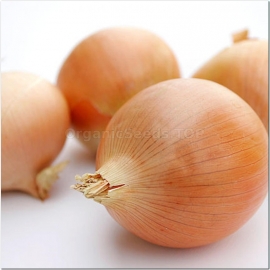
«Dorata di Parma» - Organic Onion Seeds
1.14 €
Italian heirloom storage onion with thick, yellow-brown skins and light yellow flesh that is firm, but not fibrous. An early spring planting will dependably yield a nice crop of medium to large sized globe-shaped onions.
-
Italian Heirloom Onion «Dorata di Parma»
Italian heirloom storage onion with thick, yellow-brown skins and light yellow flesh that is firm, but not fibrous. An early spring planting will dependably yield a nice crop of medium to large sized globe-shaped onions, especially with fertile soil and regular watering/rain.
Excellent long storage and rich flavor. Onions are the backbone to nearly any savory dish acting with such humility that they are often overlooked in the garden. While easy to grow from seed, the key is selecting the right type for the region. Long day onions tend to grow best in the North, when the longer days of summer trigger bulbing.
Short day onions tend to grow best overwintered in the South when the shorter days of spring are enough to promote bulbing. Intermediate day onions fall more or less in the middle. And take heart! If all else fails, any onion can be pulled and eaten as a scallion. Nutrients: dietary fiber, vitamins C, B6, folate, manganese and calcium.
How to Grow
The common practice is to break or crush the onion stems if there are signs of flower heads. When the stems are dry, dig the bulbs, which can be left on top of the ground to cure and dry for several days.
Setting out onion plants that are too large, planting too early or using the wrong varieties usually causes onions to bolt or form undersize bulbs.
The rest of the onion family; garlic, leeks, and shallots, should be planted in the fall if you're in the South and in late winter/early spring in the North. Gardeners in plant hardiness Zone 7 and further south will be mostly fall planters. From Zone 6 north check with the local Extension office for recommended planting times.
Leeks, though not a traditional southern crop, are very easy to grow as a winter vegetable from the Gulf Coast, south. The same can be said for garlic. 'Early Italian' and 'Extra Select' are softneck varieties of garlic best adapted to most gardens in the U.S. In Zones 4 and above the hardneck garlics may be worth a try.
